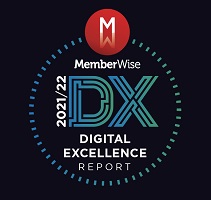MemberWise published its Digital Excellence (2021/22) Report last week. The report, the fourth published, provides an insight into the state of digital programmes in the membership space, and also some interesting reading for membership organisations and suppliers to the sector. While it’s hot off the press, we thought we’d provide some early commentary from Silverbear’s perspective.
From our perspective, it’s also great to see that Microsoft Dynamics is the leading platform being used as an AMS. Microsoft is investing billions every year in their business tools and the stack is an incredible base for digitisation initiatives. As well as benefitting from the familiarity of Microsoft (which helps speed up adoption) it also enjoys native interoperability with all their modern workplace tools (i.e. Microsoft/Office 365, Teams, and SharePoint), which the vast majority of membership organisations use every day. We were also pleased to see that we are the largest Dynamics 365 provider in the results.
Strategic challenges
It’s not entirely surprising to us, but the report highlights considerable challenges in the sector in relation to digital strategy. One of the report’s findings is that only 35% of medium and large organisations have a digital strategy, and only 25% have a data strategy.
I want to unpick this a bit because I sense the headline slightly oversimplifies the situation. ‘Digital’ is a ubiquitous term, and it certainly means different things to different people. For instance, the last fifteen months have demonstrated that most organisations have the infrastructure to support a transition from office-based working to home-based working – which is definitely a ‘digital transformation’ because digital technologies have enabled this. Many of the key statistics in the report also demonstrate that lots of digital activity has replaced, or augmented, traditional (non-digital) ways of doing things: 48% of organisations use automation tools for key tasks; 65% of organisations have an integrated website and AMS (curiously, this is down 4% from the 2019 survey); 96% of organisations monitor website analytics; 41% have an online members community (up 12% from 2019); 4 out of 10 offer a mobile app; and 94% transitioned from face-to-face to virtual or hybrid events during the pandemic. There is a lot of ‘digital’ in the sector, and most of it is being used strategically to respond to circumstances, even if that strategy is ‘we have to do this because members expect it’. Once again, the evidence for this is in the report, with 95% of organisations surveyed agreeing with the statement that “members expect an interactive, engaging, and value-driven online experience”.
Therefore, I think the critical strategic questions need to be a bit more nuanced. Do organisations have the right digital strategy? Are they ensuring that their digital strategy is delivering results? Could they improve their digital strategies by changing what they do or investing further? I think the results demonstrate that many stakeholders in the sector think more could be done, so the report’s conclusion that membership organisations should do a better job of thinking strategically and writing their digital strategies and plans down is definitely a welcome one. (As an aside, I was involved in a MemberWise Webcast about benefits realisation recently that tried to tackle this question – you can view it here.)
So, what can be done? Whole degree courses could (and do) exist about how to develop digital strategies, so I’m not intending to try here. However, the fundamental question organisations should ask is what they want “digital” to deliver for their organisation. Do they have a transformation agenda that aims to reach new types of member, deliver different services, or compete in a completely novel way? Or do they have an optimisation agenda that is focused on delivering the same services sold or delivered digitally, pursuing efficiencies, or lowering costs associated with manual or paper-based processes? (Personally, I think most membership organisations are largely focused on the latter in 2021, but this can make for an interesting debate!) Once you have decided this (or selected tangible aspects from both) you can begin making more strategic decisions that support the direction of travel, like the technology to invest in, the people and skills required, and how to measure outcomes and improvements so you can measure benefits.
Organisations don’t sound happy with suppliers
The final point I wanted to comment on is the stark conclusions on satisfaction. The low numbers paint a sobering picture for suppliers, but I suspect it also holds up a mirror to many organisations failing to get what they want from significant strategic investments.
Let me be upfront: I work in sales for a software company that serves the sector, so a large proportion of the conversations I have with other human beings are with people that aren’t happy with their existing AMS provider. However, thinking objectively, I think there are several reasons why this might be being particularly highlighted in 2021 which are worth considering:
- We are at a watershed in terms of cloud technology, with many people benefitting from the ease and convenience of cloud tools in their personal lives, but not harnessing the same from outdated, on-premises systems at work. The fact that 58% of organisations use bespoke systems (a significant number will be on-premises) and many Dynamics, Salesforce, and iMIS systems are still on legacy versions will be impacting this. By investing in cloud-based systems, many organisations can make a step-change in terms of day-to-date convenience, and it is encouraging to see that 47% of organisations have plans to upgrade with their current provider, indicating many are planning to capitalise on this.
- I suspect Covid-19 is having an impact too. Firstly, if organisations are on a legacy system then transitioning to home and hybrid-working would have been technically much harder, and no doubt older systems would be viewed in stark contrast to the new, cloud-based tools organisations had to adopt during the pandemic. It’s interesting to note that satisfaction for online meeting solutions was 8/10 – nearly three times higher than AMS platforms.
- Finally, I think there is often an incorrect assumption that systems can magically solve problems, and therefore technology is viewed as failing when it’s actually how the technology is being applied (or not) that is the real issue. There are probably lots of things your existing provider can do to support this, so a conversation about what you’re trying to achieve, and a plan to spend some money to make improvements, is probably a wise first move. It’s also sensible to bring end-users on this journey with you so that they can influence the outputs, which is a sure-fire way to increase buy-in.
A lot to do
So, the Digital Excellence (2021) Report provides a lot of food for thought for the sector and I hope many of its recommendations will be acted on by organisations seeking to deliver value to their members. In particular, there is definitely a need to work harder on delivering a vision for digital change and ensuring that investments in technology to support these deliver tangible improvements and benefits.
![]() Silverbear is (officially, and statistically viably) the UK’s leading Microsoft partner working exclusively with the membership sector. Our flagship product, Silverbear 365, is a specialist membership (/association) management system built on Microsoft Dynamics 365 and the Microsoft business applications platforms.
Silverbear is (officially, and statistically viably) the UK’s leading Microsoft partner working exclusively with the membership sector. Our flagship product, Silverbear 365, is a specialist membership (/association) management system built on Microsoft Dynamics 365 and the Microsoft business applications platforms.









Leave A Comment